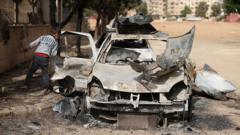The newly established Syrian government struggles to unify a fragmented nation faced with escalating sectarian violence, compelling concerns among the diverse minority groups regarding their safety.
**Syria's New Government Faces Sectarian Challenges Post-Civil War**

**Syria's New Government Faces Sectarian Challenges Post-Civil War**
The aftermath of Syria's civil war presents complex sectarian dynamics that impact the newly formed government.
The rebels who overthrew President Bashar al-Assad in December have committed to building a unified Syria. However, their efforts are overshadowed by ongoing sectarian tensions, sparking fear among various minority communities, particularly in the wake of violent attacks.
In late April, violent assaults by Islamist factions resulted in dozens of casualties in neighborhoods around Damascus, predominantly inhabited by the Druse minority. The chaos prompted Israel to intervene, launching airstrikes in defense of the Druse community. This surge in violence is particularly alarming, given that two months prior, extremist fighters were responsible for the deaths of around 1,600 people, mainly from Syria's Alawite minority along the coast, according to the Syrian Observatory for Human Rights.
Despite promises from the new regime to integrate all factions of the revolt into a newly-established national army, several extremist groups remain allied outside the government’s influence. Moreover, prominent Syrian minority groups, including the Druse, Alawites, and Kurds, have established their own armed factions, maintaining their militias from the civil war. Notably, some former Alawite supporters of Assad's regime have taken up arms against the transitional government.
Understanding the intricate fabric of Syria's diverse communities is crucial in assessing the nation's trajectory in the wake of the civil war. The delivered prospects for social integration and safety for each group remain tenuous, posing significant challenges ahead as the new government attempts to navigate its authority amidst a turbulent social landscape.
In late April, violent assaults by Islamist factions resulted in dozens of casualties in neighborhoods around Damascus, predominantly inhabited by the Druse minority. The chaos prompted Israel to intervene, launching airstrikes in defense of the Druse community. This surge in violence is particularly alarming, given that two months prior, extremist fighters were responsible for the deaths of around 1,600 people, mainly from Syria's Alawite minority along the coast, according to the Syrian Observatory for Human Rights.
Despite promises from the new regime to integrate all factions of the revolt into a newly-established national army, several extremist groups remain allied outside the government’s influence. Moreover, prominent Syrian minority groups, including the Druse, Alawites, and Kurds, have established their own armed factions, maintaining their militias from the civil war. Notably, some former Alawite supporters of Assad's regime have taken up arms against the transitional government.
Understanding the intricate fabric of Syria's diverse communities is crucial in assessing the nation's trajectory in the wake of the civil war. The delivered prospects for social integration and safety for each group remain tenuous, posing significant challenges ahead as the new government attempts to navigate its authority amidst a turbulent social landscape.




















